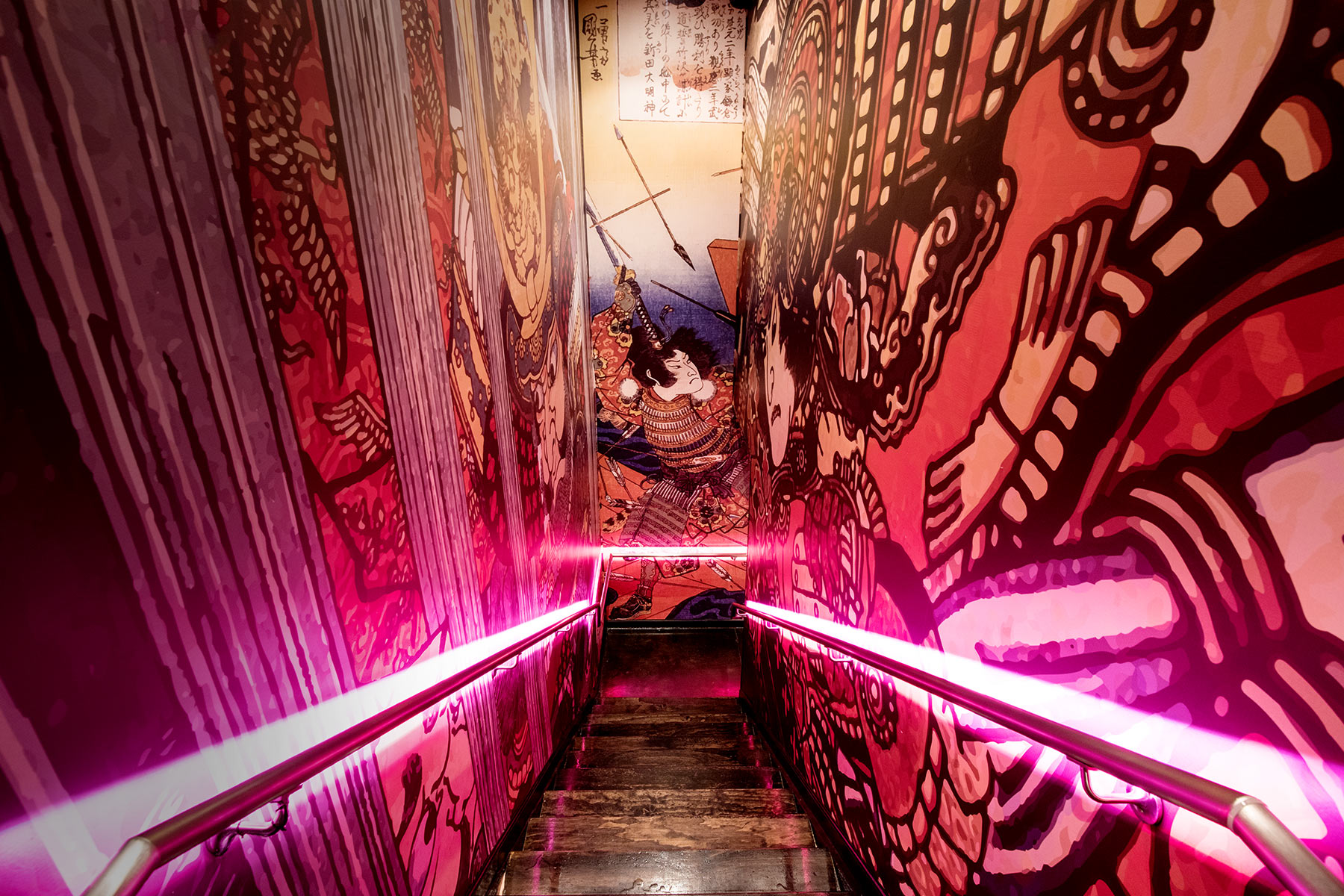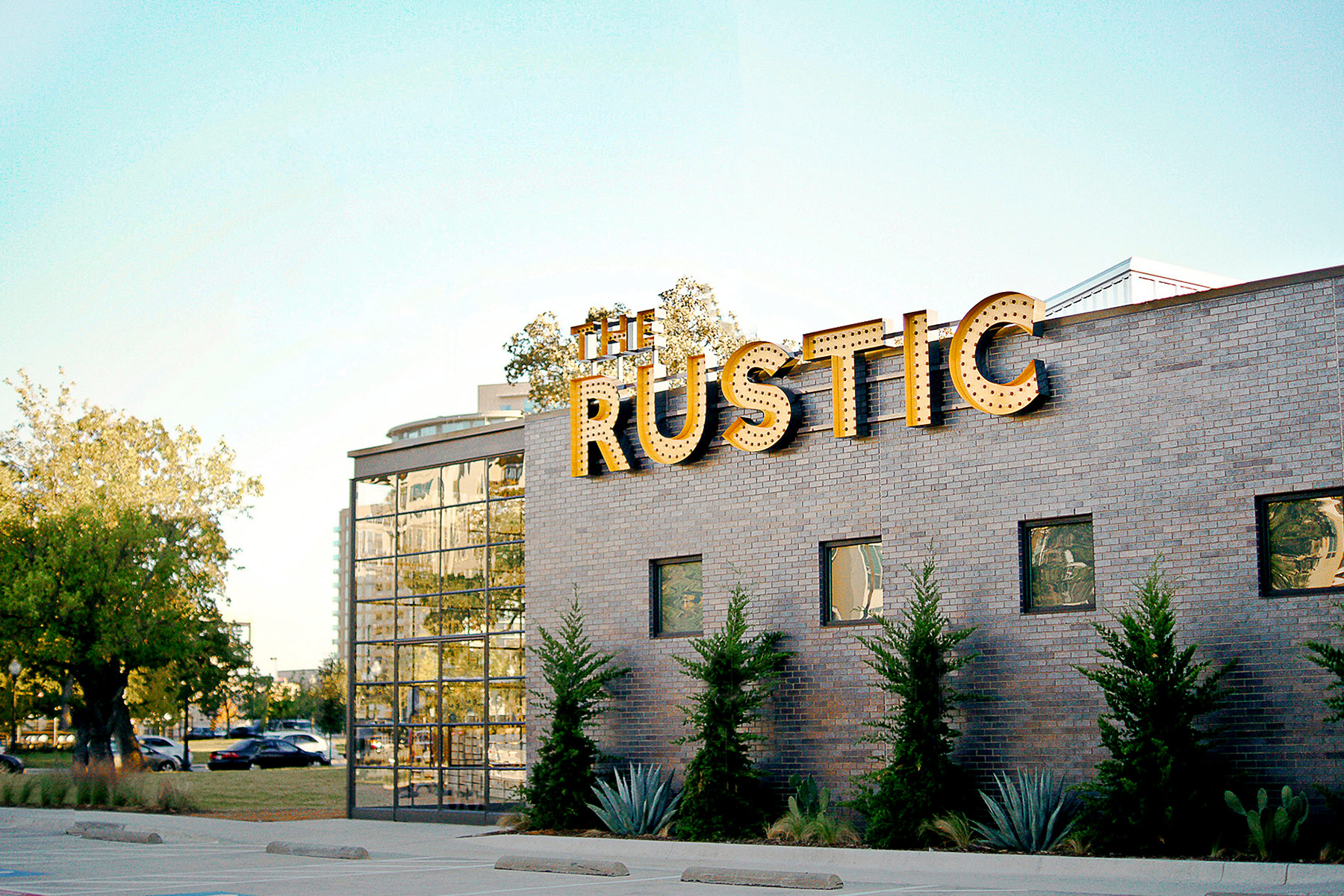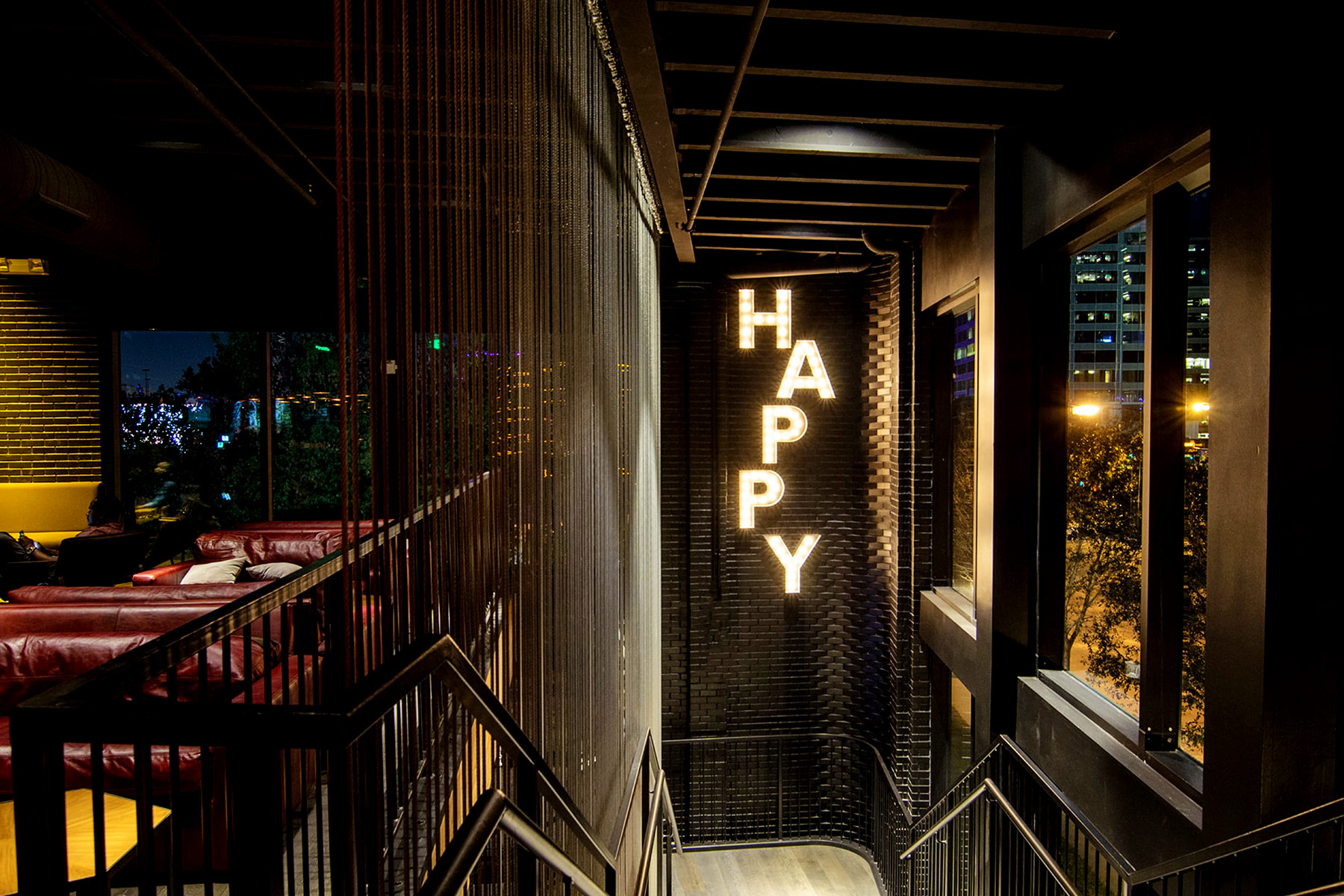The people coming in wear sneakers and sparkly jewelry and polos and even suits. In the yard, two couples take turns throwing beanbags against corn-hole boards emblazoned with the “HH” logo. At a patio table, a mother rocks her baby while her husband finishes his burger. Women in floral dresses fight over the fruit floating in their Endless Summer Sangria, a $110 fishbowl-sized shareable cocktail. On the upstairs patio, people talk closely, sway to the music, and snap selfies with the Dallas skyline glowing brightly behind them.
This bar-and-restaurant megalith, 12,000 square feet in size, offers up a variety of experiences and puts them all in one place. You can watch sports, play giant Jenga, enjoy a family meal, or pop champagne on the upstairs patio. And whatever you choose, you won’t be alone. On a weekend night, thousands of people will pass through Happiest Hour’s doors. According to a bar manager in a bright blue miniskirt, 3,700 patrons visited Happiest Hour one recent Friday.
“That was just at the tables,” she says, watching customers spill in and servers dart past with trays full of food. “That doesn’t account for people who only sat at the bar.”
But, don’t think the success at this popular spot, or any other in Dallas, is a coincidence. From its tidy industrial vibe to its small touches—like the indoor fire pit and the party games, which have a tendency to end up on Instagram—Happiest Hour was meticulously designed with the bottom line in mind.
Every Detail Counts
There are all kinds of reasons why people don’t go back to restaurants. Sometimes the problem is obvious—the place is understaffed, the food and drinks aren’t good, the servers are unfriendly or disorganized. But it could be something as small as the space just didn’t “feel” right. Maybe the lighting is too bright or too dim, the bar top isn’t a comfortable height, or the music is a tad too loud. Perhaps the space is cluttered, or the décor is distracting. A study by The Ohio State University reported that 60 percent of restaurants fail in the first three years. With so many restaurant options all over Dallas, consumers don’t have to return to a place that wasn’t “just right.”
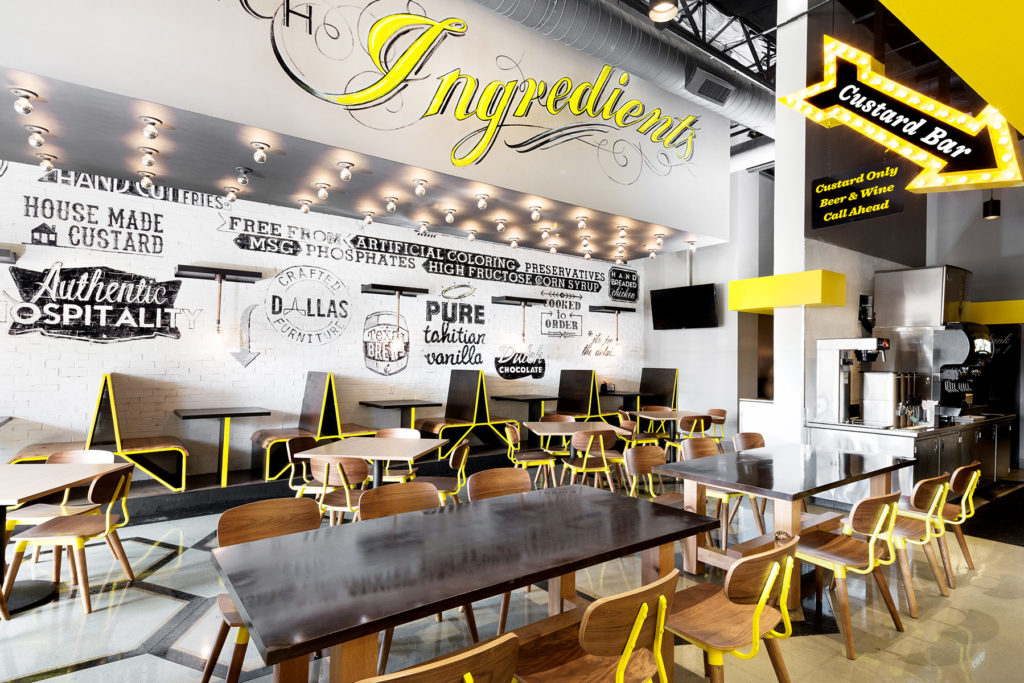
And, restaurateurs can’t afford to risk it. That’s why companies and individual operators alike shell out millions of dollars to premier North Texas firms like Coevál Studio, JonesBaker, and Plan B Group, which all build, brand, and design restaurant concepts from the ground up. These creative companies specialize in making spaces user-friendly, attractive—and profitable. In addition to those three Dallas-Fort Worth firms, there’s also Studio 11 Design, which designed Grayson Social in Dallas, Chino Chinatown in Trinity Groves, and Super Chix. Vision 360 worked on Howard Wang’s Uptown and Frisco barbecue joint 3 Stacks, and the Dallas Twin Peaks location. Dallas interior architect Kate Murphy is known for working closely with Phil Romano.
 John Paul Valverde, who started Coevál with his partner Miguel Vicens, says his company has three major components: brand creation (signage, uniforms, logo, etc.), interior environment (what the space looks and feels like), and architectural environment (how the space “flows”). He points to revenue as the ultimate indicator of a successful branding and design project.
John Paul Valverde, who started Coevál with his partner Miguel Vicens, says his company has three major components: brand creation (signage, uniforms, logo, etc.), interior environment (what the space looks and feels like), and architectural environment (how the space “flows”). He points to revenue as the ultimate indicator of a successful branding and design project.
“A lot of our focus is how to create these environments that can perform revenue-wise,” Valverde says. “The idea is to not just choose an aesthetic that looks great, but one that can also perform for the bottom line.”
When the Harwood Group came to Coevál, it wanted to create a concept that could generate a high volume of sales, but also offer a concept unique to Dallas. Happiest Hour would need a full kitchen, several bar areas, and a rooftop patio. It would be a 10-year project, Valverde says, and the Harwood Group hoped it would generate major earnings.
After meeting with Harwood, Valverde’s team came together to write a plan. They visualized the goal of each space, and contemplated everything from how the fireplace should look to the number of taps at the bar. They also brainstormed what the building would look like and what the entryway and signage would be made of. They assembled materials for their clients to touch, showcasing how the bar top and fabric of the servers’ uniforms would feel. Happiest Hour’s sheer volume would make it necessary to have menus that were easy to wipe down, so Coevál suggested laminated menus instead of paper.

The building went through three iterations before it became what it is today. “The intent is to have the operators walk through the hypothetical space and how it may feel,” Valverde says. “We listen to what they want and what they’re imagining, and ask how the Dallas public will interact with that.”
Coevál has grown to 10 employees and has gone from doing three projects a year to taking on approximately 25. Valverde, who’s trim and smartly dressed, says about 90 percent of the company’s business comes through referrals. From 2013 to 2016, he says, the company has grown a whopping 697 percent. It has tackled some of Dallas’s best-known hotspots, from trendy bars like Stirr, Next Door, and Quill, to gorgeous restaurants like Nikkei, known for the ancient-style Japanese art that glows from its walls. According to Valverde, The Rustic, one of Coevál’s first projects, earns somewhere around $12 million a year (numbers are calculated based on Texas Alcoholic Beverage Commission sales, plus a food sales estimate). And Happiest Hour, with its ubiquitous “HH” logos, skyline view, and fishbowl-sized cocktails, is estimated to bring in more than $13 million annually.
Youthful Vibe
When he saw the stucco and pink granite, William Baker knew he had his work cut out for him. Thai street food concept CrushCraft needed a hip, youthful vibe, and the operator trusted Baker’s Dallas design firm JonesBaker to make it happen. Baker is friendly and soft-spoken, with an eye for vintage and the belief that being well-traveled fosters creativity. He’s actually been on the streets of Thailand, and he puzzled over how to bring the bustling chaos of a Bangkok back alley to an Uptown eatery. Inspired by the beauty of Thai lettering, Baker asked the owner’s family back in Thailand to send their old boxes and license plates to use as indoor décor.
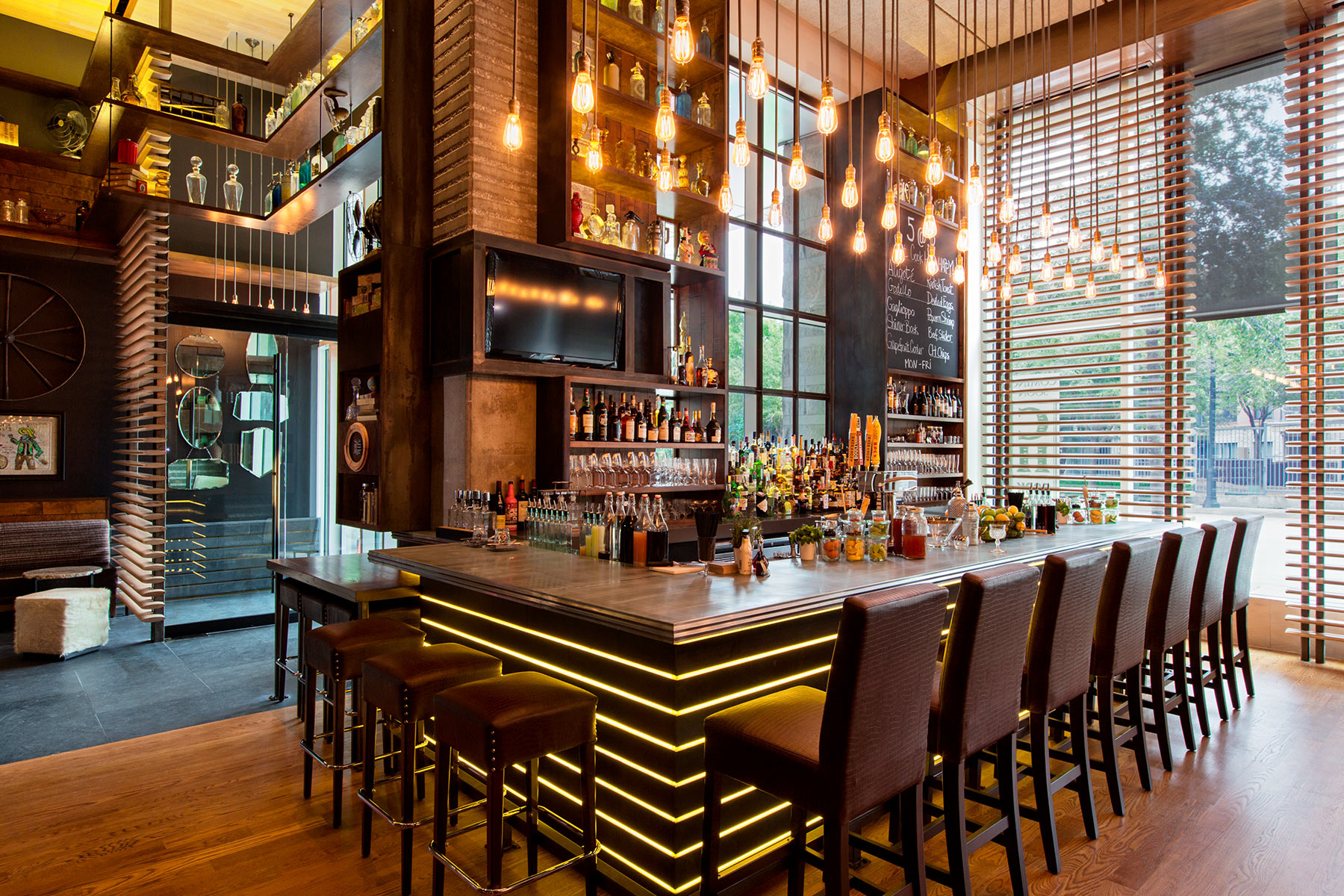

“Who else has trash sent from Thailand all the way to Dallas?” he asks.
Baker wrapped the columns of the Routh Street restaurant with the boxes and put the license plates around the order counter, evoking the feel of a busy Thai street. But the back space was the real challenge: It was a big glass postmodernist half-dome, an unattractive mix of pink granite and stucco. (Think 1980s, and not in a good way.)
The team used slat wood to cover the granite and stucco, which both modernized and warmed the space. Baker had neighbors who grew bamboo, so he asked if he could harvest a few shoots. He dried them out, tied them up with colorful ropes, and used them as ceiling décor. But the area still needed something. He’d seen prayer flags by the temples in Thailand and wondered how he might incorporate them to help fill the space.
Baker decided to have the Color Condition—a group that does streamer decorations—festoon the space with an installation. Not only did this create a festive atmosphere in a previously plain room, but the streamers are changeable. That means that every so often they’re swapped out with different colors—which creates a whole new set of photo ops.
“The streamers played right into social media and Instagram,” Baker says. “Everyone wants to take a selfie. Now CrushCraft is thinking of doing a second location. They’re like, ‘We have to have the streamers.’”
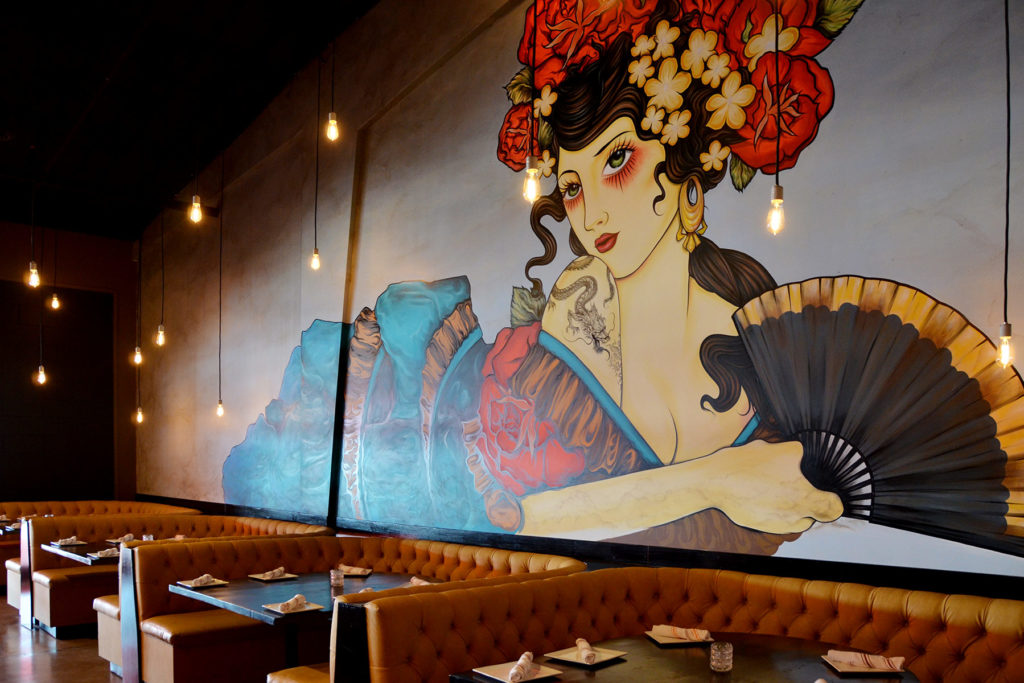 Baker, along with his partner, JB Jones, started JonesBaker in 1998. In their early days, the two worked out of Jones’s apartment on little projects—a bathroom renovation for an acquaintance here, a small-scale design for a dive bar there. “In those days, we were begging for every $400 check,” Baker says.
Baker, along with his partner, JB Jones, started JonesBaker in 1998. In their early days, the two worked out of Jones’s apartment on little projects—a bathroom renovation for an acquaintance here, a small-scale design for a dive bar there. “In those days, we were begging for every $400 check,” Baker says.
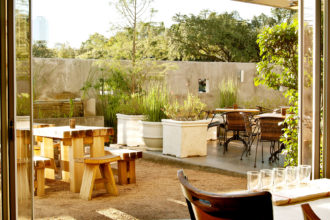 Since then, they’ve grown to eight employees and operate now out of a 3,500-square-foot office building tucked along Akard Street. They’ve worked on some of Dallas’s most notable restaurant locations, including Meso Maya, Rusty Taco, Cook Hall, and Meddlesome Moth. They’re working on their 16th location of Cru wine bar, and have done 12 locations for the Flying Saucer Draught Emporium. (These project names are kept in order by year on a list of several sheets of printer paper, all taped together in a daunting chain.) JonesBaker also did Bowl & Barrel, which started as a well-proportioned space in a tidy shopping center at Park Lane. They variously raised and lowered the ceiling and changed up the brick patterns in an effort to eliminate the cookie-cutter feel. The result is an atmosphere that’s industrial and trendy, but still comfortable.
Since then, they’ve grown to eight employees and operate now out of a 3,500-square-foot office building tucked along Akard Street. They’ve worked on some of Dallas’s most notable restaurant locations, including Meso Maya, Rusty Taco, Cook Hall, and Meddlesome Moth. They’re working on their 16th location of Cru wine bar, and have done 12 locations for the Flying Saucer Draught Emporium. (These project names are kept in order by year on a list of several sheets of printer paper, all taped together in a daunting chain.) JonesBaker also did Bowl & Barrel, which started as a well-proportioned space in a tidy shopping center at Park Lane. They variously raised and lowered the ceiling and changed up the brick patterns in an effort to eliminate the cookie-cutter feel. The result is an atmosphere that’s industrial and trendy, but still comfortable.
“We created a Brooklyn warehouse look inside a shopping center box,” Baker says. “People want that authentic vibe, so we superimposed a new geometry onto a real regular place.”
Their revenue has grown more than 10 times since their first year, and these days JonesBaker generates more than $1 million annually. Last year, they completed 36 projects. “Dallas’s endless need for restaurants makes this a good place for us to be,” Baker says. “Dallas is a breeding ground for restaurant concepts.”
The Brand DNA
In a competitive market like DFW, restaurant concepts need everything from a solid space and stunning interior design to the right signage, a great logo, and perfect music if they’re going to last past their first three years. The idea that unites all of these elements is what Royce Ring and Alex Urrunaga of Plan B Group call “the brand DNA.” They’ve been restaurant operators themselves, so they know what works—and what doesn’t.
“We offer turnkey services that bring everything together under one roof,” Ring says. “The brand DNA helps us address the food, beverages, service, operational flow, design, and all other aspects that come into play to make a thing what it is. It sets a path, or a truth north compass for the project.”
When Plan B embarked on the creation of Bolsa in the Bishop Arts District, the true north was simple: Create a neighborhood café. (Urrunaga and Ring co-own Bolsa.) The restaurant would utilize locally sourced food and be the kind of place people could dine at more than once a week. At the time, Bishop Arts was still in its infancy, and Hattie’s and Tillman’s were some of the only other restaurants in the area.
Restaurant concepts need everything from a solid space and stunning interior design to … perfect music.
Bolsa is in a relatively small building—it used to be an old garage—so Ring and Urrunaga knew they needed to focus on the patio. An invigorated open-air space, they realized, was essential. But linking indoor and outdoor settings is often a challenge. “Patios are really important, particularly in Dallas—everyone loves to be outside on a spring day,” Ring says. “We’re big believers in having a cool, energized, functional patio.”
They came up with the idea of a two-sided bar by demolishing part of one wall. The effect? “You’re able to sit on the patio and look into the restaurant,” Ring says. “It has this connectivity.”
Ring is energetic and quick with a smile, and Urrunaga is a little more reserved and thoughtful. But neither lacks a sense of humor. On their website, their staff’s profile photos are all of Will Ferrell in his various roles, and their loft-style office showcases a neon sign that says “It’s business time.” The two often finish each other’s sentences and, together, they’ve been working their creative magic since founding Plan B Group in 2005.
“We try to create pockets of interest within the restaurants we design,” Urrunaga says. “You could sit at the bar, and that feels very different than sitting at a communal table, or on a sofa in the middle of the restaurant. You’ll notice different details from different vantage points.”
 Besides having a hand in the Pie Tap Pizza Workshop+Bar, Plan B helped the owners of Greenville Avenue Pizza Company redesign their brand in small steps over the course of nearly three years. They’ve written contracts for as little as $10,000 and for as much as $400,000. They’ve used subtle tricks, like making restaurant tables a little smaller than standard to evoke a more intimate setting. They furnished Whiskey Cake Kitchen & Bar with a host of services—everything from picking out the plush couches to programming the music, building the website, and even coming up with the name. They even have the foresight to anticipate what the children of millennials might look for in a setting.
Besides having a hand in the Pie Tap Pizza Workshop+Bar, Plan B helped the owners of Greenville Avenue Pizza Company redesign their brand in small steps over the course of nearly three years. They’ve written contracts for as little as $10,000 and for as much as $400,000. They’ve used subtle tricks, like making restaurant tables a little smaller than standard to evoke a more intimate setting. They furnished Whiskey Cake Kitchen & Bar with a host of services—everything from picking out the plush couches to programming the music, building the website, and even coming up with the name. They even have the foresight to anticipate what the children of millennials might look for in a setting.
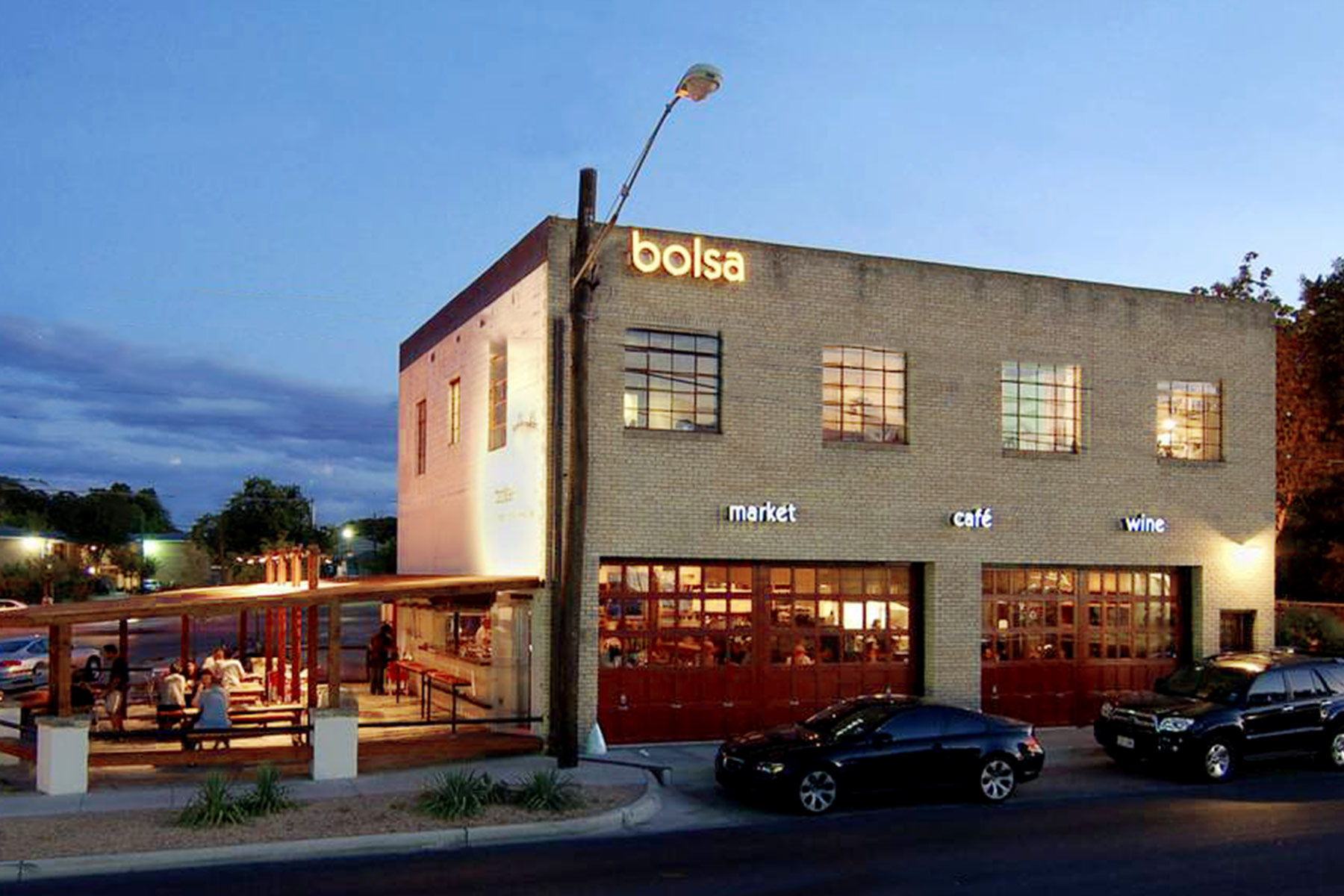

“It’s about designing a space so it’s relevant in five years, or relevant in 10 years,” Ring says. “The worst thing you can do as a designer is treat it like fashion, so that after six months, it’s out of style.”
Since Plan B’s start 12 years ago, revenue has grown “nine or tenfold,” according to Ring. He and Urrunaga view their projects as the best advertisements for their company. “We live and die by our work,” Ring says. “We have more people come to our office based on having been to one of our restaurants than with anything else we could do.”
Energetic Environment
It’s dinner hour on a Monday night, and Pakpao Thai is packed. Like Happiest Hour, this laid-back Thai restaurant in the Design District was designed by Coevál Studio. But the two spaces don’t have much in common. “We try to push a new aesthetic on everything we do,” Valverde says. “We think about the operator’s budget and be sure we can design within it.”
“It’s about designing a space so it’s relevant in five years or relevant in 10 years.
Royce Ring, Plan B Group
Pakpao is small, little more than a tenth of the size of Happiest Hour, and its design utilizes bleach-white walls, kite décor, and understated brass and gold. Still, the space is vibrant and bustling. Big glass storefront windows unite the indoor dining space and the outdoor patio; an open kitchen is visible against the back wall. Tables sit just a smidge closer together than they might elsewhere, and the narrow bar area features bar-style dining along the windows. Nearly every corner of the area utilizes potential seating space.
“Pakpao went through four iterations,” Valverde says. “Thirteen hundred square feet is good for a quick-service restaurant, but this was a full-service restaurant. We needed stations for the waiters, a walk-in cooler, a good-sized dining space.”
In the end, the bustle—deliveries have to come in through the front door, like at a New York diner—creates an energetic environment that complements the concept. And from the floating Buddha statues on the wall near the bar to the kites that sway from the ceiling, the brand is reflected in every corner of the space, however small.
It’s these touches—along with good food and a friendly waitstaff—that come together to create a great experience. And that’s why Dallas’ top restaurant design firms are key to keeping the customers coming through the doors.


